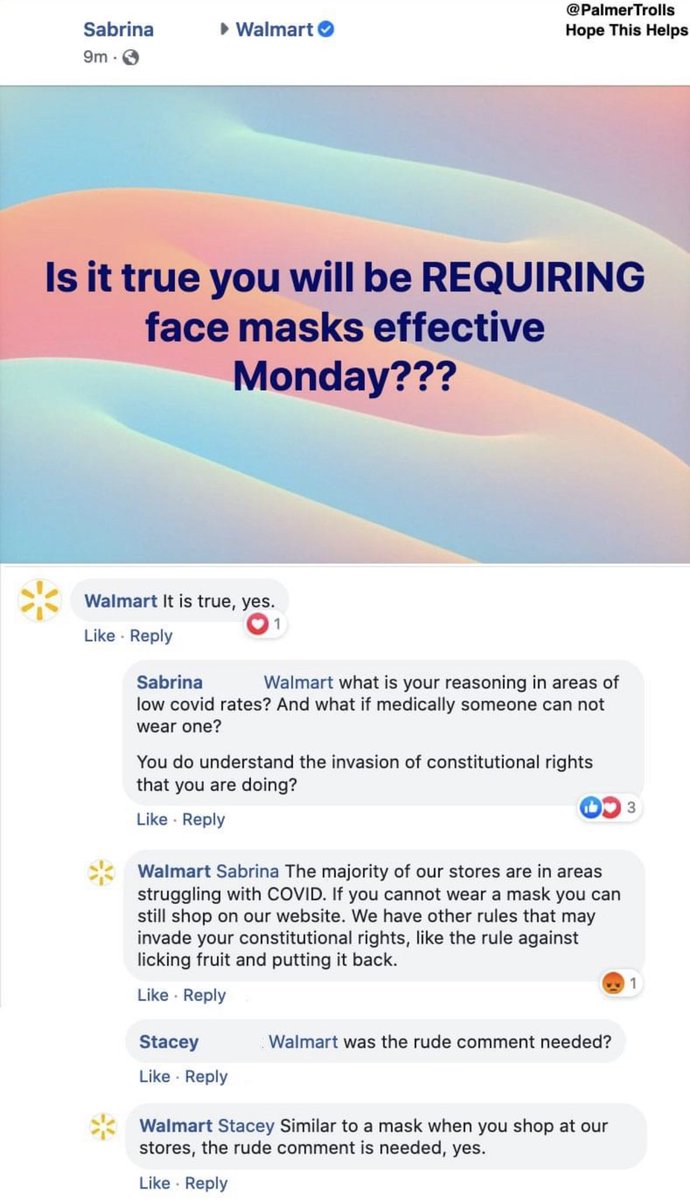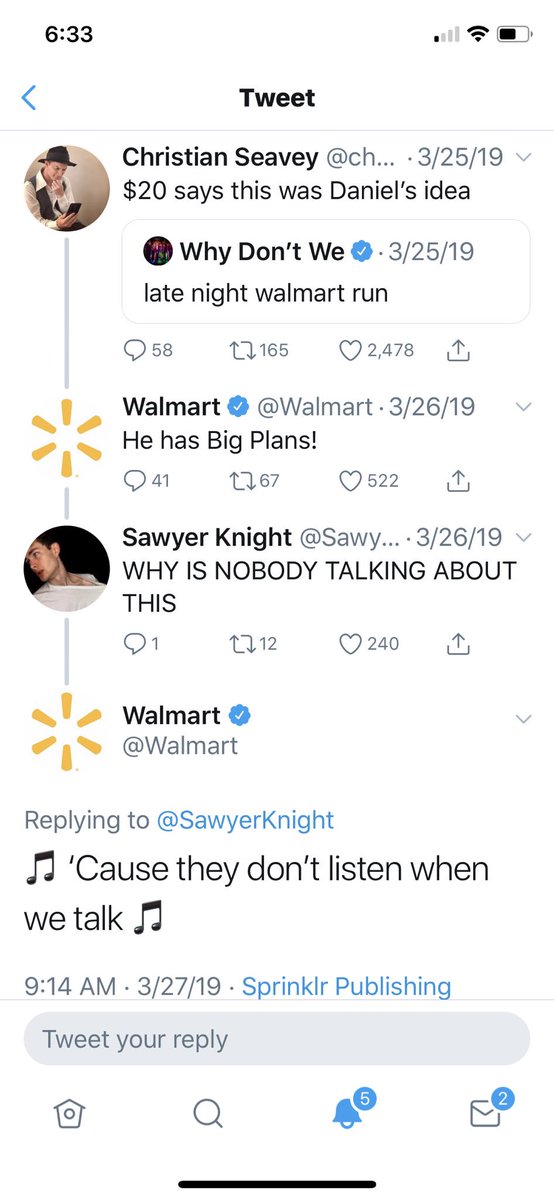Walmart Twitter
One Twitter user slammed Walmart for its ‘cheap Chinese products’ and blamed it for ‘Main Street being murdered because Big Business is in bed with China not Americans.’ Trump opponents, meanwhile, claimed that Republicans have long ignored Walmart’s controversial business practices until its Twitter account took aim at Hawley. Download jdk 7 for mac os x. Walmart World - Twitter; Walmart World Newsletter. Get the latest exclusive associate discounts, Walmart stories, and more delivered right to your inbox monthly. The latest tweets from @WalmartCanada. Despite Walmart quickly deleting the tweet, screenshots of the post circulated on social media and were eventually seen by Hawley, who decided to respond to the company. Thanks @Walmart for your insulting condescension. Now that you’ve insulted 75 million Americans, will you at least apologize for using slave labor?
Walmart Twitter Account Attacks Hawley for Electoral College Challenge, Hawley Drops Them In Epic Clapback By Nick Arama Dec 30, 2020 4:15 PM ET Share Tweet.

Join Transform 2021 this July 12-16. Register for the AI event of the year.
Walmart made $559 billion in total revenue during the COVID-19 pandemic’s first fiscal year, up from $514.4 billion in fiscal 2019, thanks in part to newly integrated internet of things (IoT) capabilities to improve food quality and lower energy consumption. Walmart claims its systems for IoT deployments are built at a scale unmatched across the retail industry: The company reports that, every day, it takes in approximately 1.5 billion messages and analyzes over one terabyte of data. This proprietary software includes a cloud-based dashboard application to manage volume and detect anomalous events, such as refrigeration failures, so they can ostensibly be fixed more quickly, saving ice cream from melting while driving corporate profit.
VP of technology Sanjay Radhakrishnan oversees Walmart’s IoT platforms and applications. Radhakrishnan sat down with VentureBeat to describe the giant retail chain’s long-term data strategy and how it’s changed since last March to accommodate changing store ecosystems across the U.S. Design software for mac download.
Walmart Twitter Playstation 5
This interview has been edited for clarity and brevity.
Playstation 5 Walmart Twitter
VentureBeat: How would you describe Walmart’s approach to IoT at a high level?
Sanjay Radhakrishnan: When we started on this journey, we had three key objectives. One was to address this at the scale of Walmart’s, that Walmart can actually leverage the impact of IoT at Walmart scale. The second objective was to ensure that we are the control plane for our data. So, we control where our data lands, and we have the ability to convert into business insights. And then the last objective was really maintaining that connection to our end customer experience. And then ensuring that we are being good corporate citizens, with respect to our sustainability initiatives. So just want to set the stage that when we started on this IoT journey, those were the three main drivers that we were looking to solve.
VentureBeat: I’m really interested in that IoT journey. Could you tell me more about how Walmart has evolved its tech platforms over the past couple of years? And what has that progression has looked like, maybe in the past 5, 10, even 15 years?
Radhakrishnan: You know, with those three objectives in the background, we have always had all kinds of devices in our stores. And these devices typically come from vendors or original equipment manufacturers (OEMs) that actually manufactured these devices. Typically this equipment comes with some kind of an HDMI human machine interface that’s on the machine, so you can actually go connect to it and collect data out of these devices in a one-off fashion.
And we’ve always done that. But with this IoT journey, what we really wanted to do was we wanted to move into the driver’s seat, where we can actually normalize these datasets coming from all these different machines, different devices, and different OEMs. We normalize that data, and we control our data using IoT from these devices and provide those data sets to our business in a way where we can actually convert them into useful information and useful insights and really improve that end customer experience. So our journey really has been, instead of individual point-to-point access from these individual machines, on how we can grow this at scale by being the control plane and getting all this data from equipment, normalize it, and simplify it into our language so that we can do intelligent things things with it, right? And so that focus is really shifted inside Walmart by building our own software that we are using to form that control.
VentureBeat: That’s fascinating. And, in building this proprietary software at such a great scale, did Walmart run into any particular kinds of challenges or problems that it then worked to overcome?
Radhakrishnan: The biggest challenge we have is just the variety of devices that we have in our ecosystem. They come from different OEMs, they are across different generations of these devices, and they all speak different languages. And what this means to us is, in our world, we are dealing with a wide mix of sensors, a range of protocols, and really a myriad of information models. So our approach has been to look at how we build our software and where we are talking to all these devices. You know, talking to the different protocols. But we have an ability to kind of normalize all of that data into one consistent IoT specification. That’s a Walmart IoT specification. And then we apply the right kind of data quality checks, so that we can certify the data and drop it into our control plane. And then we take it from there.

So once we are able to connect the devices to our control plane, then we can land the data, either at the edge or the cloud. And afterward our software engineers can build all kinds of applications for our business customers. And we really kind of looked at this in a cloud-agnostic fashion. So we ensure that we have a dual-pronged strategy with our infrastructure. We leverage infrastructure in our own datacenters, and we also leverage infrastructure as a top cloud provider. The focus really has been to ensure that our IoT pipeline software can access the right infrastructure at scale, considering things like latency and connectivity concerns.

VentureBeat: Within this group of devices you mentioned, are you including in-store ones like refrigeration systems from the ice cream case study?
Radhakrishnan: Yeah, that’s right. So you walk into the store and you see a lot of refrigeration cases. We are talking about sensors that are actually inside these refrigeration cases. And they are connected to what we call controllers in the store. We are actually connecting into those controllers and pulling device telemetry signals. It’s a lot of operating functions that you’re getting out of the equipment, and we are getting it in a consistent manner, in a continuous stream, to do intelligent things.
VentureBeat: For the refrigeration IoT tech, could I hear more about how that’s architected in the cloud? Are there any specific foods, like ice cream or frozen pizzas for example, that are easier or more difficult to maintain with the technology?
Radhakrishnan: We stream from edge to the cloud, and we have different pathways in the cloud based on data usage patterns. Our IoT applications can access data across the edge and cloud to solve business problems. We are cloud agnostic and leverage a dual-prong strategy that includes access to infrastructure in our own datacenters and top cloud providers. And our focus has been to ensure that our IoT pipeline software can access the right infrastructure at scale, considering connectivity and latency constraints. The type of food in the refrigeration cases does not cause differing complexity of our system.

VentureBeat: Do you have any statistics on whether Walmart food quality has been more consistent since IoT tech was implemented? I’m curious if there are any specific stores or products that have seen a particularly measurable difference.
Radhakrishnan: What I’ll say is, our focus has been on how you drive operational efficiencies in the store. For example, when things go wrong in the store, technicians actually fix problems with this equipment that is in the store. So the focus has been on how you get the right technician to the right place at the right time so that we can proactively address issues. Because if you don’t, it could impact product quality. Since we have started this journey, just by looking at reference duration, we have been able to improve our refrigeration equipment health by an average of 30%.
VentureBeat: On a related note, I remember reading about Walmart’s intention to limit energy consumption. Could you tell me more about how that energy approach is architected in the cloud? Are there any specific frameworks or data strategies that Walmart is using to accomplish that?
Radhakrishnan: If you look at our architecture and our frameworks, I would say it’s everything from connecting to the devices to using sophisticated infrastructure and software that runs on the edge and actually knows how to connect to these devices while holding telemetry data. Now, it depends on our use cases. If they’re kind of low latency use cases, then we store data at the edge, and we have logic at the edge to fulfill those use cases.
Otherwise, we are streaming data to the cloud. And in the cloud, we have multiple kind of patterns depending on data usage. We might extend the data into kind of a cold pack, or a one pack, and our IoT applications have the ability to access the data, either at the edge or in the cloud. They can basically build business applications and solve business problems. So, if you’re talking about frameworks and the technology stack, it’s a mix.

We use Walmart homegrown and open standard frameworks like Spring and .NET Core, our device protocols. We can connect to devices all the way from BACnet to Modbus to serial communications to some of the more recent protocols like HTTP and Simple Mail Transfer Protocol (SMTP). If you look at the tech stack itself, typically our device drivers are written in Java, and the applications themselves are all ReactJS, not GS applications that use Linux-type operating systems.
VentureBeat: I’m interested in hearing more about how individual elements of Walmart’s tech stack — choices like Spring tools, for example — specifically help with IoT deployments. How and why do specific tools work well for Walmart’s use cases, like scaling large volumes of data?
Radhakrishnan: Messages are generated by the equipment (such as HVAC and refrigeration controllers) in the stores and processed by software on edge infrastructure. From the IoT edge infrastructure, messages are then sent to our cloud storage to be processed and consumed by software applications. We use a hybrid approach of edge and cloud computing depending on the type of data. The data is sent over our secured network to our proprietary solution that has multiple architectural components and micro services. We use a mix of Walmart internally developed and open standard frameworks like Spring Boot and .NET Core. Our strategy is to build our software to be cloud agnostic, so we use common frameworks and languages such as Java, Embedded C, React, Node JS, and Linux technologies.
Our focus is really trying to make sure that we map the right technology to solve the right business problem. We always start with the customer in mind. What is the use case? What’s the business? How do our internal customers solve thinking of the end customer in mind, and then work our way back to what does that mean for tech and then what’s the right tech stack to actually fulfill that. So, I mean we are pretty open, and the focus really is on understanding the customer problem, and then marrying it to the right tech stack to solve that problem.
Walmart Twitter Feet
VentureBeat: Could you tell me a little bit more about Walmart’s IoT developments in the last year, and how they’ve helped the chain adjust to the COVID-19 pandemic’s challenges?
Radhakrishnan: The pandemic has definitely opened new proper business problems and use cases for us where IoT is extremely useful to leverage. For example, when the pandemic hit, we reduced hours in our stores, so our associates could restock inventory and sanitize stores for our customers. We have this system called Demand Response, which is one of the IoT applications that we have built in-house. And we were able to leverage that to a working model, where we can control the temperature settings in the stores to adjust to these new hours, and that brought a lot of productivity to our associates. Instead of using more constrained and manual approaches, now they have an actual system, where they can do remote deployment of capabilities and really control our high-performance computing (HPC) systems in a remote manner at scale. From a productivity angle, it helped the business, and also from a sustainability angle, we were able to reduce the energy consumption on the grid. So to give you an example, our system was able to execute shredding events. We did it for about 200 sites, and we were able to save enough electricity to roughly power 20-plus U.S. households for a year. That gives you a scale for how we are giving back, both in terms of productivity for our associates and also in terms of sustainability.
VentureBeat: How has Walmart’s existing IoT and tech infrastructure allowed for its engineers to create new capabilities, like the COVID-19 responses, so quickly?
Radhakrishnan: Over the last few years, we have moved to the driver’s seat, where we built software that will normalize and control our data using IoT from these devices, converting the data to insights that the business can use in decision-making. We apply the right data quality checks to certify the data and bring the data into our control plane. We were able to incorporate real-time data streaming and improve the speed at which issues are identified and resolved in a highly accurate manner. Having this foundation in place has allowed us to quickly respond to external factors, like adjusting store hours overnight during the early response to COVID-19. Another recent example of the IoT technology allowing us to respond quickly would be in February, when the extreme cold weather impacted energy grids in numerous communities. We had the necessary controls in place for demand shedding already, so we were able to apply the tool in a new way that controlled HVAC heating set points and reduced our energy consumption. In less than two days, we used the technology to successfully reduce the HVAC energy consumption in almost 500 stores.
VentureBeat: Are there any other digital platform technologies related to ML, blockchain, IoT, or ERP Walmart is deploying? And are there any in particular that Walmart wants to research next?
Radhakrishnan: For our IoT use cases, we are looking at ways we can further improve the customer experience and our impact on the communities we serve. Through algorithms, we will continue to update our algorithms as we identify trends between what the data is telling us and how we should respond. Through equipment, we will identify other equipment that we can connect to that would provide a benefit to our customer for remote diagnostics and proactive maintenance.
VentureBeat
VentureBeat's mission is to be a digital town square for technical decision-makers to gain knowledge about transformative technology and transact.Our site delivers essential information on data technologies and strategies to guide you as you lead your organizations. We invite you to become a member of our community, to access:- up-to-date information on the subjects of interest to you
- our newsletters
- gated thought-leader content and discounted access to our prized events, such as Transform 2021: Learn More
- networking features, and more
